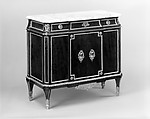Commode
Jean Henri Riesener French
A set of three commodes, one larger one, and a pair of smaller, matching ones, were commissioned from Riesener in 1786 for the use of Marie Joséphine of Savoy, Comtesse de Provence at Montreuil. The description and dimensions given in Riesener’s mémoire or bill are very similar to this commode which would have been one of the two smaller pieces. Especially, the use of the concave frieze and the design of the gilt-bronze mounts make it very likely that this commode was one of the three supplied to the Comtesse de Provence. However, since no special stamp was used for the Garde Meuble of the Comtesse de Provence, this commode can only be linked to her on the basis of the description.
This image cannot be enlarged, viewed at full screen, or downloaded.


